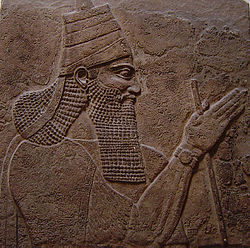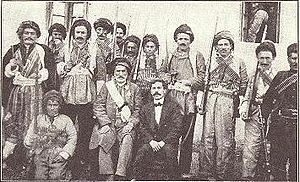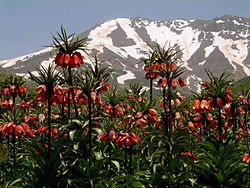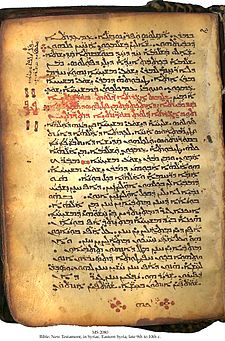- Nochiya Tribe
-
For other uses, see Nochiya (disambiguation).
The Nochiya Tribe (Syriac: ܡܠܬ ܕܢܒܼܟ̰ܝܼܐ Millet D'Nochiya), are an Assyrian Christian tribe that were based in and around the district of Şemdinli, in the province of Hakkari, Turkey. The word "Nochiya" means "between the mountains" in the Kurdish language. They are called Nochiya Assyrians (Syriac: ܢܘܿܟܝܼܝܐ Nochiyaye) and as Metropolitan's Tribe ("Millet D'Matran"), with an estimate over 20,000 remaining dispersed throughout the world.[1]
Nochiya Tribe Est. 1663 A.D.
Ethnicity Geography Language People Religion Settlements Contents
People
The Assyrians of the Nochiya Region were simple farmers who owned cattle and grew food. They were particularly known for their fine tobacco which was their main source of income along with herding sheep. Prayer and fasting were strictly observed in the villages of belonging to the Nochiya Assyrians. An Englishman visiting the Nochiya Region in the late 19th century a noted that "there is perhaps no Assyrian district where simple piety and loyal devotion to the church of their fathers is more beautifully seen than Nochiya".[2] Nochiyaye were and are still today most famous for their Eastern Rite faith and for being the guardians of the Assyrian Church of the East's canon laws, which they have faithfully preserved.[3]
The Assyrians of the Nochiya Region were sometimes referred to as "B'Shashtu".[1] They received this nickname because of the conical felt cap which at one time was worn by Nochiya Assyrians called a "Shashta". The Assyrians of Urmia refer to the people of Nochiya tribe as "Shapadtnayeh", which is the old name for the area before the Ottoman-Persian border split in 1515.[1]
Collectively the ten clan-districts of the Nochiya Region contained some 65 villages that eventually became known as the Nochiya Tribe in 1663, with the appointment of the first Metropolitan of Şemdinli, from the Matran family of the Gida House. The Ottoman Empire did not integrate the Nochiyaye as an official tribe within their "millet" social structure, nonetheless they were recognized as an independent tribe by their Assyrian and Kurdish neighbors.[1]
Clothing
The famous felt cap worn by the Nochiyaye is a white conical cap made of wool-felt material, similar to that worn by the ancient Assyrian kings and Bishops, known as a "Shashta", hence; the tribal nickname B'Shashtu. The Shashta can be worn either with or without a turban, known as a "Shashikta".
 Assyrian king, Tiglath-Pileser III, wearing a Shashta similar to the one worn previously by Nochiyaye.
Assyrian king, Tiglath-Pileser III, wearing a Shashta similar to the one worn previously by Nochiyaye.
Second, the cummerbund (Kharkhasa) tied around the waist is knotted, not looped.
Third, the clothes although similar to other Assyrian and Kurdish tribes are not patterned or striped but made of plain choice mohair wool.
The men's outfit consists of wide straight-legged trousers, buttoned shirt, a jacket tucked into the baggy trousers and a short pocketless waistcoat (Karika), usually white in color. Of course, a cummerbund to tie everything together round the waist and finally a "Shashta Cap" with an optional red turban.
Language
Syriac alphabet
(200 BCE–present)ܐ ܒ ܓ ܕ ܗ ܘ ܙ ܚ ܛ ܝ ܟܟ ܠ ܡܡ ܢܢ ܣ ܥ ܦ ܨ ܩ ܪ ܫ ܬ All Assyrian tribes speak the same language but differ in their dialects. The Nochiya tribe all speak with the same dialects, from Targawar in the north to Rawandiz in the south. It is practically impossible to differentiate between their Aramaic dialects.[1]
This is one of the most bonding factors in Assyrian tribes and it's interesting that the tribes adjacent to the Nochiyaye; Urmijnaye to the east, Gawarnaye to the north, Jilwaye to the west and Barwarnayeh to the southwest, all have completely different accents, to the point that some are almost unintelligible to the Nochiyaye.[1]
Society
The Nochiya tribe is not a "tribal confederation", but is based on the "bond of kinship" (tukhma). This point is important and what it means is that the ten clans are not just unified by leadership or geographical factors alone but primarily by blood and so cannot be separated, they are shackled by the "bond of kinship", which defines their tribal affinity to outsiders.[1]
To further illustrate this point, the Rawandiz Clan in the late 19th century changed both religious and leadership loyalty to the Chaldean faith but did not change their tribal identity. In fact, they still proudly identify themselves as "Catholic Nochiyaye".[1]
Kinship is an essential ingredient and the basis of any tribe. By contrast, some European tribes are only paternally related, however Assyrian tribes are both paternal and maternal. The Nochiyaye are mostly paternal descendants of the Matran family of the Gida House, the rest are mostly related maternally.[1]
Leadership
An Assyrian tribe must have both religious and civil leaders to qualify as a tribe. This principle is called Gooraneh.
In the case of Nochiyaye it was the Metropolitan (Matran) of Shamizdin who was the religious chief and his brother was always the civil chief who presided over the local lords (Maliks) of the Nochiya Region, such as Malik Tammu of Sararu, Malik Breemu of Badtemu, Malik Diryawish of Ambeh and Malik Samu of Baigardeh.
The Matran controlled the religious figures such as Mar Dinkha of Tees and Mar Youkhanan of Dariyan and various others, such as the archdeacons and priests within the tribe. He was primarily the Archbishop of the Assyrian Church of the East and was second in command only to the Patriarch, Mar Eshai Shimun XXIII.[1]
Geography
Main articles: Nochiya Tribal Region and List of Nochiyaye settlementsThe Nochiya Tribal Region is unique in that it spreads over into three countries: Turkey, Iran and Iraq[citation needed]. The reason for this is that the Nochiya Tribe predates these international borders. The Turkey-Iran border created in 1515 after the Battle of Chaldiran split the Targawar, Bagzadeh and Margawar Clans away from the Şemdinli district, this natural extension of the Zagros mountain range, overnight, became part of Iran. The Turkey-Iraq border cut away the Bradost and Sherwan Clans from Shamizdin in 1926, with the signing of the Sykes-Picot Agreement.
Districts
The Nochiya Region is an area which consists of provinces, districts and sub-districts. The Nochiya Region lies in three different countries: western Iran, northeastern Iraq and southeastern Turkey. The districts that make up parts of the Nochiya Region are Şemdinli, Soran District, Mergasur District and the western part of Urmia District.
Rustaqa was the central sub-district of the Nochiya Region. To the north of Dağ İçinde in the district of Şemdinli, Turkey were the clan-districts of Khumara and Dairaneh; to the east, in the district of Urmia, Persia were the sub-districts of Bagzadeh, Margawar and Targawar. To the south, in what is now modern day Arbil, Iraq were the sub-districts of Gargan, Bradost, Sherwan and Rawandiz.
Religion
Main article: Christianity in NochiyaThere was at least six monasteries and more than 40 churches within the Nochiya Region. The Nochiyaye were best known for their adherence to the Nestorian faith, religious customs such as lent and prayer were strictly observed. The Mar Ishu Monastery in the village of Mar Ishu was a theological school for priests and was run by the Metropolitans of Shamizdin, who would not tolerate any changes to the church's canon laws.[2]
 Mar Yosip Khnanisho at his home in Baghdad, Iraq
Mar Yosip Khnanisho at his home in Baghdad, Iraq
An Englishman visiting the Nochiya Region in the late 19th century noted that "there is perhaps no Assyrian district where simple piety and loyal devotion to the church of their fathers is more beautifully seen than Nochiya". Nochiyaye were and are still today most famous for their Nestorian faith and for being the guardians of the Assyrian Church of the East's canon laws, which they have faithfully preserved.[2]
There were other important religious figures in the tribe, including two bishops, four archdeacons, twelve priests and a large number of deacons distributed among the clans. To this day, the majority of the priests and deacons within the Assyrian Church belong to the Nochiya tribe, including the Patriarch Mar Dinkha IV.[3]
Mar Iskhaq Khnanisho IX
Mar Iskhaq Khnanisho, was the spiritual leader of the Shamizdin Assyrians and Metropolitan of the Assyrian Church of the East. Previously, he was styled as the Metropolitan of Rustaqa. His Diocese in 1914 grew to included Shamizdin, Targawar, and Margawar. In his diocese were bishop Mar Dinkha in the village of Tis, an ancestor of the present patriarch of the Assyrian Church of the East, Mar Dinkha IV; bishop Mar Youkhana of the village of Tulaki in Targawar, and after 1914 his own nephew Mar Yosip Khnanisho X who was ordained a Bishop on the eve of World War I in Qochanis by Patriarch Mar Benyamin Shimon XXI.
Saint Mar Yosip Khnanisho X
Main article: Saint Mar Yosip Khnanisho XThe 10th and the last of the metropolitans the Matran family donated to the Church was Mar Yosip Khnanisho, who died on July 3, 1977, in Baghdad, Iraq. At an early age, while a young boy he was aware for what sublime position he was dedicated, thus he had learned by heart the complete Eucharistic rites, performed in the church by a deacon or priest. He was tutored adequately by a learned scholar, Rev. Rehana, his father's uncle, who was well versed in the Aramaic, Russian and Turkish languages and an authority in Eastern theology. Rev. Rehana was the head of the Seminary in Mar Ishu Monastery and he taught classes to a number of students studying for the priesthood. From this seminary many graduated to become bishops and priests in various dioceses and parishes.
At age twelve, Mar Yosip was ordained a deacon. By 1912 Mar Yosip had already acquired a thorough knowledge of theology therefore he was found to be well suited to be ordained a priest. In the year 1914, at the beginning of World War I, he was sent as a delegate, representing the Metropolitan Mar Iskhaq Khnanisho, to participate in a most important meeting called by His Holiness Mar Benyamin Shimon XXI, the Catholicos Patriarch at the patriarchal cell in Qudchanis, Turkey, to discuss the effects of the World War on the Church and the nation and prepare for the changes that were expected to take place. While there he was consecrated a bishop on August 10, 1914, by His Holiness and was appointed as assistant to the patriarch.[4]
He remained in Qudchanis until 1916 when the Assyrians had to leave their homeland and possessions in consequence of the Great War. After the treacherous assassination of the Patriarch Mar Benyamin Shimon XXI in 1918, Mar Yosip assumed to a great extent, the leadership of the nation, until the Assyrians arrived in the refugee camps, set up by the Red Cross and League of Nations, at Baqubah, Iraq in 1918. In December 1918 he was elevated to the rank of Metropolitan in Baghdad by Patriarch Mar Paulos Shimon XX.[4]
When Mar Eshai Shimun XXIII, the Catholicos Patriarch, was exiled in 1933 by the monarchial regime of Iraq, Mar Yosip Khnanisho was entrusted with the Church administration in Iraq and the Middle East.
In 1973 when Mar Eshai Shimun XXIII resigned his position as the Catholicos Patriarch, Mar Yosip Khnanisho was vested with responsibilities of administering the Church of the East throughout the world. At the same time, the Iraqi government issued a Republican decree appointing Mar Yosip Khnanisho as the supreme head of all the Assyrians in Iraq.
On July 3, 1977, at 1:10 PM Saint Mar Yosip Khnanisho X died in Baghdad, Iraq. His death coincides with the feast celebrated every year in memory of Mar Tooma Shlikha (St. Thomas the Apostle).[4]
History
During World War I, a genocide took place within the Ottoman Empire which decimated the Nochiya Assyrians along with all the other Assyrian Tribes. They were blindly misled by the Allied Forces who promised a lot and delivered nothing. In the end, the war took its toll on the Nochiyaye, who lost their villages, lands, houses and churches. The battle turned into a religious one, surrounded by hostile Muslims, the Nochiyaye had no choice but to flee southwards, away from the raging enemy. Led by the metropolitan Mar Iskhaq Khnanisho IX, the tribe left its ancestral mountains, never to see them again. The Nochiya tribe is also referred to as the "Royal Tribe" because they are related to the ancient monarchs of Assyria.
Urmia, Iran (1915–1918)
At the end of the Assyrian Genocide, in a matter of just a few years the population of the Nochiya Tribe was drastically reduced from around 12,000 to 4,000 as a result of the war, they found themselves in Urmia where they spent three years. Then in 1918, they made the long trek to the Baqubah and Mandan safe camps in Iraq.
Baqubah (1918–1920)
In Baqubah, 4,000 Nochiya Assyrians stayed in the camps for two years under the care of the British Army. As the Assyrians were segregated into large tents according to tribe, the Nochiya Assyrians had a separate dwelling area.
Sumail (1920–1928)
In 1920, they relocated again this time to Sumail and the villages around it (such as Graipan) for a period of eight years until 1928, before they eventually settled in the Arbil province, distributed amongst various villages.
Arbil Province (1928–1963)
The majority of the Targawar and Margawar Nochiya Assyrians headed for Habbanya and others to Baghdad and Kirkuk, some other tribal members fled to Syria, where they established the village of Tell Faitha. The Matran family however, along with their tribal members settled in twelve villages in the Arbil province, those villages being Harir, Batas, Qalatdeh, Hinareh, Darbandokeh, Almandana, Qoba, Alaneh, Sarishmeh, Hawdiyan, Diyana and Bidyal. Graipan and Hazarjut were two villages in the Dohuk Governorate that were also partly inhabited by Nochiyaye.
There were three main reasons why they chose the governorate of Arbil, first it was geographically closer to Nochiya Region than, for example, Dohuk. In fact, it was close to existing clan areas anyway such as Rawandiz, Bradost and Sherwan that were part of the Arbil governorate.
Secondly, there was some friction with other tribes namely the Lower Tyari Tribe, who chose the Dohuk province since it too was closer to their former district; the British might have sensed this tribal agitation.
Thirdly, it was at the suggestion of Ishmael Beg of Rawandiz and Said Taha of Nehri, who by then had been appointed governors of the Rawandiz District. They had settled in Batas and invited Mar Yosip Khnanisho to be their new neighbor again since they shared clan territories pre-1915.
The Nochiyaye stayed in these villages for 35 years until July 1963 when they were defeated, fighting for an independent Iraqi Kurdistan Region against the Iraqi army. After this upheaval, the Nochiyaye left their villages and fled to major cities such as Arbil, Kirkuk and Baghdad. The residents of Hawdiyan and Bidyal however were not uprooted by the war; they remained in their respective villages.
Modern Nochiyaye (1963 - present)
During the early 1960s, many Nochiya Assyrians resided in the city of Baghdad in the suburbs of Dora and Gailani Camp. In the 1970s and 1980s the majority of Nochiyaye immigrated to Europe and North America where the vast majority now live. Some 3,500 Nochiyaye remain in Iraq with approximately half living in Baghdad and the other half in the Iraqi Kurdistan Region. Renewed efforts are being made to re-establish the old villages of Harir, Cairu and Zariwan. The already established villages of Diyana, Hawdiyan and Bidyal are currently being re-built.
Identity issues
Village identification
Even some village members if the Nochiya Tribe are guilty of elevating their villages into tribes. One example of this issue lies within the village of Mar Bishu. Mar Bishu lies in the center of the district Şemdinli, which is the center of the Nochiya Region[citation needed].
Clan and sub-district identification
An example of sub-district identification is the Gargan, a sub-district which is located within the Şemdinli district. The land that this clan inhabited was called "Gargan", commonly known as "the land of the Gargans" (Atra D'Garganayeh) but their loyalty lied to the Matran of Şemdinli. Mistakenly, they even occasionally refer to themselves as "Gardi" (a Kurdish tribe in Gargan), distancing themselves completely from both their Nochiya Tribe and the Assyrian Christian nation.
A sub-district is not a tribe and the tribal name is always derived from where the tribal chief dwells, in this case the district of Nochiya. To further illustrate this point, had the Matran family lived in the Gargan area, the tribe would now have been known as the Gargan Tribe instead of the Nochiya Tribe.
Nowadays, many clan members wrongly assume that the name of their clan is the name of their tribe. For example, when asking Assyrians from the sub-district of Targawar what tribe they belong to, they might reply the "Targawar Tribe", when the correct answer is actually the Nochiya Tribe. There has never been an organized tribe called the "Targawar Tribe", because it is simply a geographical area belonging deep within the Nochiya Region.
See also
- Assyrian Tribes
- List of Assyrians
- List of Assyrian settlements
- Matran Family
External links
- United Nation's Maps of Iraq
- United Nation's Map of Arbil Province, Iraq
- United Nation's Map of Districts in Northern Iraq
- United Nation's Map of Mergasur District, Iraq
- United Nation's Map of Shaqlawa District, Iraq
- United Nation's Map of Soran District, Iraq
References
Categories:
Wikimedia Foundation. 2010.



